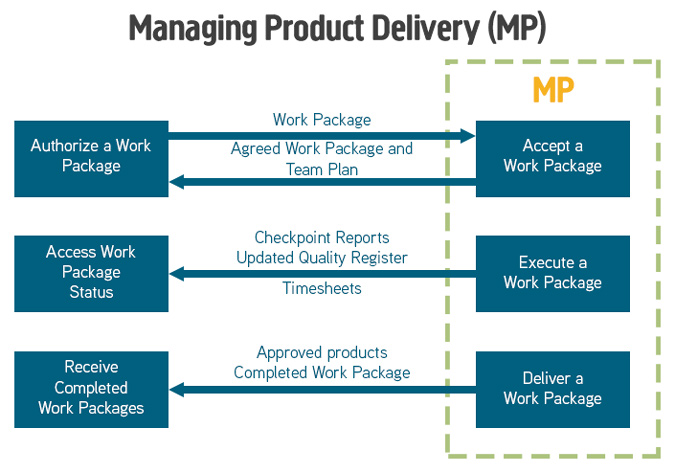PRINCE2® PROCESSES – Managing Product Delivery (MP)

The purpose of the Managing Product Delivery process is to control the link between the Project Manager and the Team Manager(s), by placing formal requirements on accepting, executing and delivering project work.
The role of the Team Manager(s) is to coordinate an area of work that will deliver one or more of the project’s products. They can be internal or external to the customer’s organisation.
The objective of the Managing Product Delivery process is to ensure that:
- Work on products allocated to the team is authorised and agreed.
- Team Managers, team members and suppliers are clear as to what is to be produced and what is the expected effort, cost or timescales.
- The planned products are delivered to expectations and within tolerance.
- Accurate progress information is provided to the Project Manager at an agreed frequency to ensure that expectations are managed.
Products that are created or updated during this process are:
- Team plans with actual dates.
- Risk register with any identified work package level risks.
- Quality register with all quality work that is being undertaken.
- Configuration Item Records with the latest status of products produced.
- Project Issues with status information and impact analysis for current or new issues identified.
- Checkpoint Reports providing regular progress information to the Project Manager.
Silicon Beach Training is an accredited training organisation for PRINCE2 Training.
Andy Trainer
12 Jul 2007
PRINCE2® PROCESSES – Controlling a Stage (CS)

The purpose of the Controlling a Stage process is to assign work to be done, monitor such work, deal with issues, report progress to the Project Board, and take corrective actions to ensure that the stage remains within tolerance.
For each stage, the following cycle of activities will be covered:
- Authorise a Work Package
- Review Work Package Status
- Receive Completed Work Packages
- Review the stage status
- Report highlights
- Capture and examine issues and risks
- Escalate issues and risks
- Take correction action
The continued assessment of risk and issues during this process is important.
Products used or produced during this process:
- Work packages, detailing the products to be produced must be agreed between Project and Team Manager.
- Quality register – checked for approved products produced
- Configuration item records – updated with the latest status of products
- Checkpoint reports – reviewed in preparation for Highlight reports
- Highlight Reports (time-driven control) produced by the Project Manager, sent to the Project Board advising on progress information.
- Issue reports and Issues register in which all issues are captured and examined.
- Daily log – used to informally manage any risks and issues
- Lessons Log – updated with any lessons learned during the stage
- Updated Risk register.
- The Stage Plan which is regularly updated with actual achievements.
- An Exception Report may also need to be created if an issue is forecast to exceed stage tolerances.
Learn more about the Controlling a Stage Process on our PRINCE2 Courses.
Andy Trainer
12 Jul 2007
Within the Managing Product Delivery phase of the PRINCE2® framework, there are three distinct stages regarding the Work Package that must be completed and documented.
In our post 'Getting Work Done with PRINCE2' our trainer Claudine explains Work Packages in relation to the Controlling a Stage process. In this post we will outline the Managing Product Delivery aspects of Work Packages and the actions necessary for successful completion.
You can learn more about work packages in PRINCE2 on our PRINCE2 Training.
Purpose of Process
It is important to understand what the intended results of the Managing Product Delivery process are:
- To set out and decide upon the requirements with the Project Manager
- To do the work
- To keep the Project Manager updated on progress
- To sanction the completion of the work
- Make the Project Manager aware of the completion of the work
The reason it is important to know the purpose of this process is because if at any point there is contention or an issue that must be addressed, everything has been documented and carried out according to a set structure and so can be easily accessed and acknowledged.

Andy Trainer
7 Jan 2013